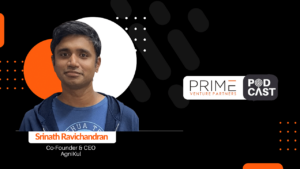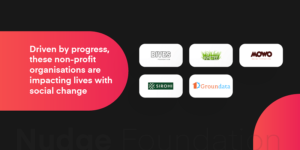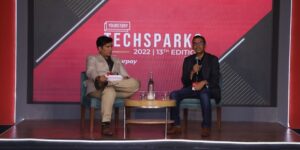Ramesh Kumar Katreddi, the Vice President of Engineering at B2B marketplace Jumbotail, grew-up in a regular middle-class family in Hyderabad. Although he spent his formative years studying at a Telugu medium school, it was never a limitation for Ravi, whose love for technology and problem-solving transcended language barriers.
“What got me intrigued about technology was watching my brother, who was already doing his engineering. His experience gave me an exposure to computer science and software engineering. It was also the time when Google was making waves,” recalls Ramesh.
Ramesh had started learning HTML and CSS to build small websites, his first attempt at coding.
“It is where it all started, and I started to prepare to join IITs, which was coming from Telugu medium, as I had to understand everything from scratch,” says Ramesh.
In School
After his schooling, Ramesh chose to join the National Institute of Technology (NIT) at Warangal in 2007. Always a school topper, he recollects being consistently analytically driven.
He also admits his family played a strong influence in all of his choices. Seeing his sisters and brothers build new things, it helped Ramesh make the choices. “For me, it was all about solving puzzles and that is what everything looked like, so by the time I was 20, for me it was an easy choice,” explains Ramesh.
He says once he started coding there was no looking back. After joining NIT, the push to code more and build new things had significantly increased. “We had the best professors, and every weekend we would build codes and work on different projects. Our assessments were based on the projects we did and how and what we learnt during the process of building,” recollects Ramesh.
Getting a grip on coding
By the final year, students at NIT Warangal were able to participate in significantly high-level coding competitions. This pushed Ramesh to understand problem solving better, and he opted to spend some time as a research assistant at the International Institute of Information Technology (IIIT), Hyderabad. Later, he joined IBM for an internship in 2010.
At IBM, Ramesh was responsible for creating a research project on Railway Ticket Booking, through an interactive voice response in Hindi. The idea was to make it work with different regional languages.
“It was a great experience – working on an experimental product of building a voice recognition system to recognise Hindi by lexical analysis. The system was built to convert Hindi speech to test, it had a 50 percent success rate. At that time, this was a big deal, considering the accents and tonal variations,” explains Ramesh.
He was at IBM until 2011, and during this stint, he managed to build the interactive voice response system that uses text to speech. Ramesh also helped with storing data and transaction management of the ticket booking.
Not long after, Ramesh got through campus placement to join Adobe. “It was an interesting day, where I had to do a presentation at the IBM Bengaluru office that morning, and then be back in Hyderabad by evening to take part in campus placements. I was one of only two people to be placed on the same day,” says Ramesh.
He is confident college and the internships helped him push himself better, and working in a large corporate like Adobe helped him understand the importance of working with teams and different kinds of people.
Coding for Dreamweaver
“I predominantly worked on Dreamweaver at Adobe. It was simple, and someone who didn’t know HTML or coding could still build a website by just dragging and dropping the key elements,” explains Ramesh. He adds the idea was to focus on how well they could contribute.
Ramesh feels although Dreamweaver is a no-fuss web design and development tool, it gave him a rich experience as its code base was significantly complex. He worked on iterations of the same until 2013, and and after that, as a member of the senior technical staff, Ramesh continued to build new features and visual tools for Dreamweaver and creative cloud.
Ramesh went on to hold the title of Computer Scientist at Adobe, where he built systems to sync users data across the systems in real time as part of the creative cloud. This was around 2015 when Android too was picking up, and WhatsApp systems were growing.
“Startups in India were becoming big. I was exploring how exactly WhatsApp works, more around how the code was working etc. The android backend and sequence coding really intrigued me. Mobile apps weren’t there at Adobe at that time,” says Ramesh.
This intrigue though, was the genesis of his new startup in 2015, WhatsDplan, an event aggregation and group planning platform that helped users discover, plan, and book activities and events together.
The journey to Jumbotail
Speaking about his experience running his first startup, Ramesh says, “We got good recognition and awards, and once there was a momentum, I quit my job with Adobe to build the product along with a friend. We built the company and integrated it with Zomato, and the plan was to have all the restaurants, movies, and fun activities in one digital place. However, the startup didn’t pan out due to supply demand challenge. Group buying bookings were different and needed significant discounts. Nevertheless, the whole experience gave me significant exposure and learnings into building a business and how things work,” explains Ramesh.
Soon after shutting shop, he joined Jumbotail in 2017.
“The scale of the problem that Jumbotail was solving and building intrigued me significantly. The scale of the challenge was high. When we look at supply chains, we understand that they create and form the backbone of the hyperlocal and B2B e-grocery segment. At Jumbotail, I am building and leading the engineering team. We believe that there is power in technology to transform the future of retail,” says Ramesh.
At the Bengaluru-based wholesale and food grocery platform, Ramesh has built the entire supply chain system from scratch with smart warehouses, financial and logistics systems, multi-tenant seller systems, and credit and marketplace platforms in place.
And while Ramesh may not code every day at this stage, he believes it is important to build and continue to code. “It is always about problem solving. And what is the best solution,” says Ramesh. He feels while most techies believe they need to use the newest and the best technology and language available, it is about having the right solution for a problem.
He concludes, “Even while hiring, I look at the ability of a coder to solve a problem and look at the best solution for any problem. I always ask, are they willing to push themselves, are they willing to find different solutions?”

![You are currently viewing [Techie Tuesday] From coding for Adobe’s Dreamweaver to building ecommerce platform Jumbotail, the journey of Ramesh Kumar Katreddi](https://blog.digitalsevaa.com/wp-content/uploads/2022/03/CopyofImageswithserieslogos-1647272131776.jpeg)







